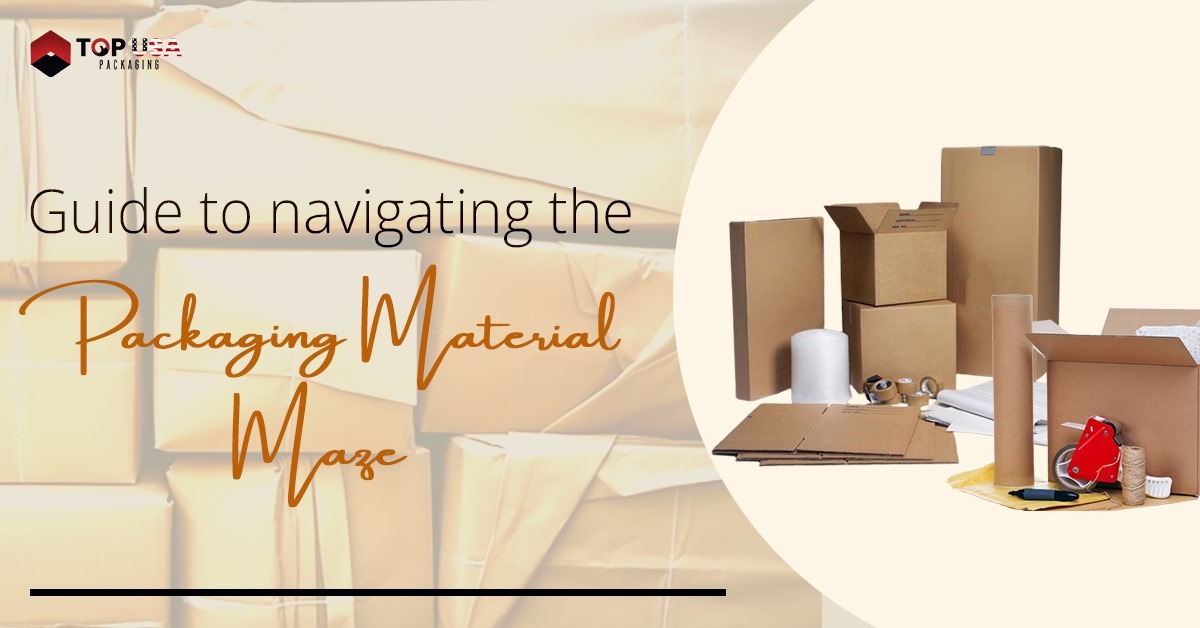Guide to Navigating the Packaging Material Maze
In the age of online commerce, packaging has transcended its purely functional role. It’s become a brand’s silent ambassador, the first impression that greets customers in their unboxing rituals. But beyond the glossy visuals lies a strategic battlefield – the choice of material. Cardboard, plastic, glass, and beyond, each option comes with its own strengths and weaknesses, demanding careful consideration.
TopUSAPackaging understands the weight of this decision. As your trusted packaging partner, we’re here to equip you with the knowledge to navigate the material maze and make the best choice for your product, brand, and budget. So, dive in with us as we explore the most common packaging materials and discover their potential!
Most Common Packaging Materials and Their Potential
Cardboard: The Uncrowned King of Sustainability
Lightweight, versatile, and readily recyclable, cardboard reigns supreme in the eco-conscious world. TopUSAPackaging offers a variety of corrugated cardboard options, from single-wall for everyday items to triple-wall for heavy-duty protection. Its customizable nature allows for crafting custom packaging boxes in diverse shapes and sizes, perfect for retail displays, product bundles, or custom mailer boxes.
Pros:
- Eco-friendly: Made from recycled paper and readily recyclable itself.
- Cost-effective: Affordable and often cheaper than other materials.
- Lightweight: Reduces shipping costs and carbon footprint.
- Versatile: Printable, customizable, and suitable for various product types.
Cons:
- Susceptible to moisture: Not ideal for liquids or products sensitive to humidity.
- Limited weight capacity: May not withstand heavy or fragile items.
- Branding limitations: Can be challenging to achieve premium aesthetics.
Plastic: Durable Defender or Environmental Enigma?
Plastic offers undeniable sturdiness and weather resistance, making it ideal for protecting delicate or perishable goods. From wholesale packaging boxes for beverages and food to custom cosmetic containers, plastic provides a secure and hygienic shell. However, sustainability concerns loom large, urging responsible sourcing and recycling practices.
Pros:
- Durability: Protects products from damage and harsh environments.
- Water resistance: Ideal for liquids, food, and sensitive items.
- Lightweight: Comparable to cardboard in weight, reducing shipping costs.
- Versatility: Available in various forms and with customizable features.
Cons:
- Environmental impact: Non-biodegradable and contributes to plastic pollution if not recycled properly.
- Potential safety concerns: Some plastics may leach harmful chemicals, especially for food packaging.
- Branding limitations: Can appear generic and less premium than other materials.
Glass: The Touch of Elegance with a Fragile Heart
For brands aiming for a luxurious and sophisticated image, glass packaging exudes undeniable finesse. From sleek wine bottles to chic perfume vials, glass elevates the unboxing experience and enhances product perception. However, its fragility and weight necessitate extra care throughout the supply chain.
Pros:
- Premium aesthetics: Conveys high value and exclusivity.
- Reusable and refillable: Sustainable in the long run.
- Preserves product integrity: Ideal for protecting sensitive items like fragrances and food.
- Visually appealing: Showcases products beautifully, enhancing branding.
Cons:
- Fragile: Prone to breakage during shipping and handling.
- Heavy: Increases shipping costs and carbon footprint.
- Higher production costs: More expensive than cardboard or plastic.
- Not suitable for all products: Not ideal for heavy or delicate items.
Beyond the Big Three: Exploring Niche Packaging Materials
The packaging world extends far beyond the usual suspects. For brands seeking to stand out, a plethora of unique materials offer creative possibilities. Bamboo for a touch of natural elegance, metal for industrial chic, or even recycled fabrics for a sustainable statement – the options are endless.
Remember: When making your packaging material selection, consider these key factors:
- Product characteristics: What level of protection does your product need? Is it sensitive to moisture or light?
- Brand identity: Does the material align with your brand values and target audience?
- Sustainability goals: How eco-friendly is the material, and can it be recycled or reused?
- Budgetary constraints: What is your cost per unit, and does it fit within your budget?
TopUSAPackaging: Your Packaging Partner in Exploration
As you embark on your packaging material journey, TopUSAPackaging stands beside you as your trusted advisor. We offer a comprehensive selection of materials, from cardboard boxes wholesale to custom-crafted pieces, ensuring you find the perfect fit for your needs. Our expert team will guide you through the material maze, considering your specific requirements and budget.

